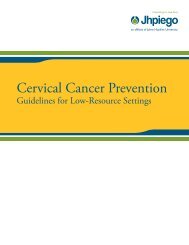Manual for Male Circumcision under Local Anaesthesia
Manual for Male Circumcision under Local Anaesthesia
Manual for Male Circumcision under Local Anaesthesia
You also want an ePaper? Increase the reach of your titles
YUMPU automatically turns print PDFs into web optimized ePapers that Google loves.
<strong>Male</strong> circumcision <strong>under</strong> local anaesthesia<br />
Version 3.1 (Dec09)<br />
referred to a specialist centre. The circumcision team should<br />
enquire about the health of the baby or young boy.<br />
Neonatal circumcision (within the first 28 days of life) should be<br />
<strong>under</strong>taken only if the birth was a full-term delivery and the<br />
baby has had no significant medical problems. Known<br />
haematological disorders and jaundice are contraindications to<br />
circumcision. Thus any baby with yellow sclera or purpuric skin<br />
lesions should not be accepted <strong>for</strong> clinic-based circumcision.<br />
Any congenital abnormality of the genitalia is a contraindication<br />
to circumcision. Only babies with a normal physical<br />
examination and an intact, completely normal appearing penis<br />
and <strong>for</strong>eskin should be considered <strong>for</strong> male circumcision. This<br />
is because the <strong>for</strong>eskin may be needed <strong>for</strong> plastic surgical<br />
repair of the abnormality.<br />
CONSENT<br />
In all cases, the procedure can be <strong>under</strong>taken only with the full<br />
consent of the parent or legal guardian. The parent or legal<br />
guardian should be fully in<strong>for</strong>med about how the procedure will<br />
be done, what type of anaesthetic will be used, what<br />
complications are possible, and what type of postoperative<br />
care should be provided. A summary of the in<strong>for</strong>mation that<br />
needs to be provided is given in Appendix 6.1. The consent of<br />
the child should also be obtained, if he is able to give it<br />
(Chapter 3 addresses this issue in more detail). An example of<br />
a consent <strong>for</strong>m is given in Appendix 6.2.<br />
PREPARATION<br />
Be<strong>for</strong>e the procedure, the baby should be clean and have a<br />
clean, freshly-la<strong>under</strong>ed or new disposable nappy. Because<br />
mothers may need to travel some distance to the clinic, any<br />
clinic offering infant circumcision should have facilities <strong>for</strong><br />
washing babies and changing nappies.<br />
ANAESTHESIA<br />
<strong>Anaesthesia</strong> is recommended <strong>for</strong> paediatric circumcision.<br />
Many studies have shown that babies react to pain, and that<br />
an effective method of providing local anaesthesia is with<br />
dorsal penile nerve block. a The maximum safe dose of<br />
lidocaine in children is 3 mg/kg of body weight. For a 3-kg baby,<br />
this corresponds to 0.9 ml of 1% solution or 1.8 ml of 0.5%<br />
solution (see Table 5.1). Anaesthetic solutions containing<br />
epinephrine (adrenaline) should never be used.<br />
a<br />
Kirya C, Werthmann MW Jr. Neonatal circumcision and penile dorsal nerve block: a painless<br />
procedure. J Pediatr. 1978;96:998-1000.<br />
Infant and paediatric circumcision Chapter 6 - 2
















